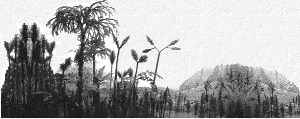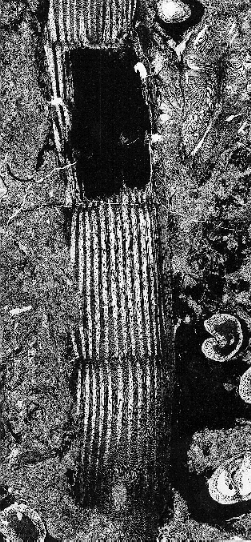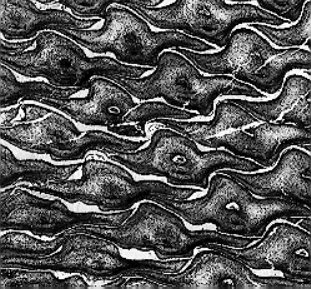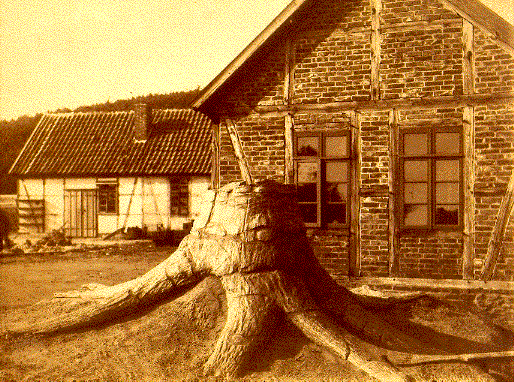
Part 2
 Fig. 1: Longitudinal section through a calamite in coal ball preservation, upper Namurian of the Ruhr district. |
After the surprisingly fast radiation of land plants in the Devonian, the Carboniferous is characterised rather by a further diversification of the already existing groups, than by the appearance of new groups. Because of their increasing size and complexity, it becomes more difficult to reconstruct these fossil plants. Larger plants are never found complete but always as isolated fragments and organs. This can partly be ascribed to biological processes, such as the abscission of leaves and the dispersal of seeds, but also to sedimentary processes such as fragmentation during the transport from the place where the plants grew to where they were finally embedded in the sediment. Such fragmentary plant remains are classified in form genera. These form genera are defined on the basis of morphological characters and they do not necessarily reflect natural relationships. The presence of different modes of preservation can further complicate the study of fossil plants. Compressions and impressions are the most widespread preservation type and the cell pattern of the epidermis can be studied in the very resistant cuticles when the organic material is still preserved. Another important type of preservation the are permineralisations. The best known type is the silification. Silicifications are frequently found in areas with active volcanism. Other important permineralisation types are the pyritisation and the so-called coal balls. These latter are carbonate concretions which were formed in peats before these were transformed into coal. In these concretions cell cavities are filled with calcite or dolomite, whereas the organic matter forming the cell walls is still present (Figs. 1 and 2). Coal balls are one of the best sources of anatomical information on Carboniferous plants. |
| Although also Devonian coals are known, especially during the Late Carboniferous thick peats accumulated which were later transformed into coal. During the Carboniferous large parts of Europe and North America were situated in an equatorial position and extensive swamp forests developed in the wetland areas at the continental margins. The largest Carboniferous basin is the so-called Paralic Basin which extended from Ireland, over England, northern France, Belgium, The Netherlands, Germany (Ruhr District) into Poland. Temporary sea level changes resulted in flooding of the lowland areas and marine sediments were deposited. Marine bands are intercalated in the mainly terrestrial sequences. Also on the continents several, usually smaller, so-called epicontinental or intramontane basins, in which also peat-forming swamp vegetation types occurred, developed (e.g. the Saar Basin, Germany). |  Fig. 2: Outer surface of a Lepidophloios stem, an arborescent lycophyte showing the typical leaf scars. Coal ball from the Pennsylvanian (Upper Carboniferous) of North America. |
 Fig. 3: Stem base of a Sigillaria from the upper Westphalian of the Piesberg near Osnabrück. Photograph taken in 1886, shortly after its discovery. |
Other elements of the Carboniferous coal swamp forests were the tree-like Calamites (Fig. 1) which belong to the group of the sphenopsids. These could be up to 20 m high and grew predominantly in very wet environments like at lake margins. Most common are the pith casts, the infillings of the central cavity. Other important groups include the pteridosperms or seed ferns, the ferns and the cordaites, distant relatives of the conifers. On the basis of their anatomy and the organisation of the reproductive organs several groups of pteridosperms can be distinguished. They had fern-like fronds which could reach a considerable size in several species; some authors assume a frond size of at least 4 m for some forms. Pteridosperms are commonly reconstructed as small trees but there is increasing evidence that at least some of the species with smaller fronds had a vine- like growth habit. The pteridosperms also grew in somewhat drier environments like the sandy levees. Many ferns were tree-like, but also climbing and epiphytic forms have been described. The cordaites are a difficult group. They have very characteristic, up to 70 cm long strap-shaped leaves. They are gymnosperms; their seed-bearing parts and pollen sacs were organised in cones. Therefore this group is often considered to be related to the conifers. The identification of cordaite wood is difficult because smaller fragments can easily be confused with conifer woods. Although Cordaites basically had the same type of foliage, several different growth forms have been demonstrated, ranging from 45 m high trees to smaller creeping bushy plants. A similarly wide variation can be demonstrated for their ecology, ranging from mangrove-like plants over swamp elements to typical representatives of the drier hinterland floras.